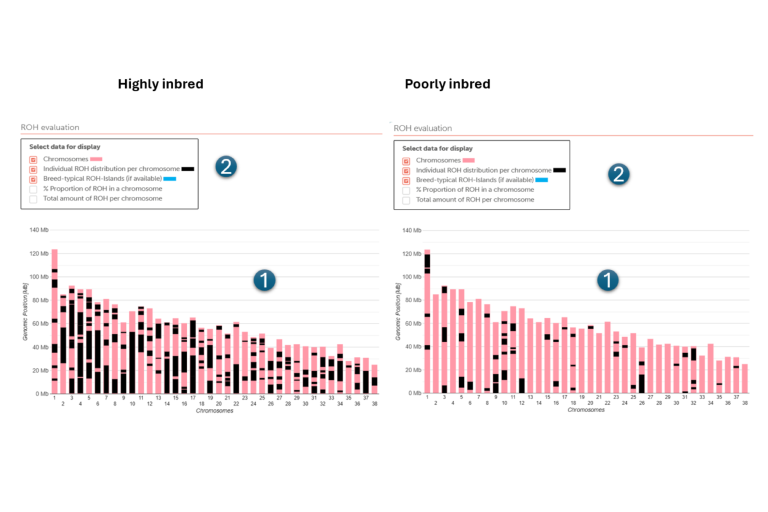ROH Profile
Runs of Homozygosity (ROH) are contiguous segments in the genome where an individual has inherited identical genetic segments from both parents. The ROH profile illustrates the distribution of these segments across each chromosome, including their length. Animals that are high inbred exhibit larger ROHs regions (> 5 MB).
The ROH profile provides insights into the nature of existing inbreeding, distinguishing between recent inbreeding events (mattings between parents or grandparents) and population-based inbreeding (a high level of inbreeding within the population due to breed development).
Testing and Results
ROH Profile
In the animal's record under the Genetic Diversity section, the results of the Inbreeding & Fitness test are displayed. The ROH profile is part of this analysis.
Here, for example, are the ROH profiles of two dogs: on the left, a heavily inbred dog with a GIC of over 40%. On the right, a dog with a low ROH proportion and GIC under 10%.
The ROH profile is represented with a bar chart that displays each chromosome as a pink bar, and overlays the inbred segments in black. The chromosomes are arranged from left to right on the x-axis, while the y-axis represents the size of the chromosomes and the inbred segments in megabases (Mb)
In the filter menu, you can select how the ROH segments are displayed on the chromosomes. The available options include:
- Chromosomes + Individual ROH Distribution per Chromosome: This is the default display, showing each chromosome as a pink bar with inbred segments overlaid in black, arranged from left to right on the x-axis, with the y-axis representing the size of the chromosomes and the inbred segments.
- Breed-Specific ROH Islands (if available): Displays inbred segments that are fixed and typical for a breed.
- % Proportion of ROH in a Chromosome: Shows the percentage of each chromosome affected by inbreeding.
- Total Extent of ROH per Chromosome: Shows the absolute length of the ROHs on a chromosome relative to its absolute length.
Sources
https://pubmed.ncbi.nlm.nih.gov/30429214/
https://www.nature.com/articles/s41598-021-85262-x#Sec2
https://gsejournal.biomedcentral.com/articles/10.1186/s12711-020-00581-3
https://bmcgenomics.biomedcentral.com/articles/10.1186/s12864-021-07872-z#Sec6
https://journals.plos.org/plosgenetics/article?id=10.1371/journal.pgen.1010651
https://cgejournal.biomedcentral.com/articles/10.1186/s40575-021-00111-4

